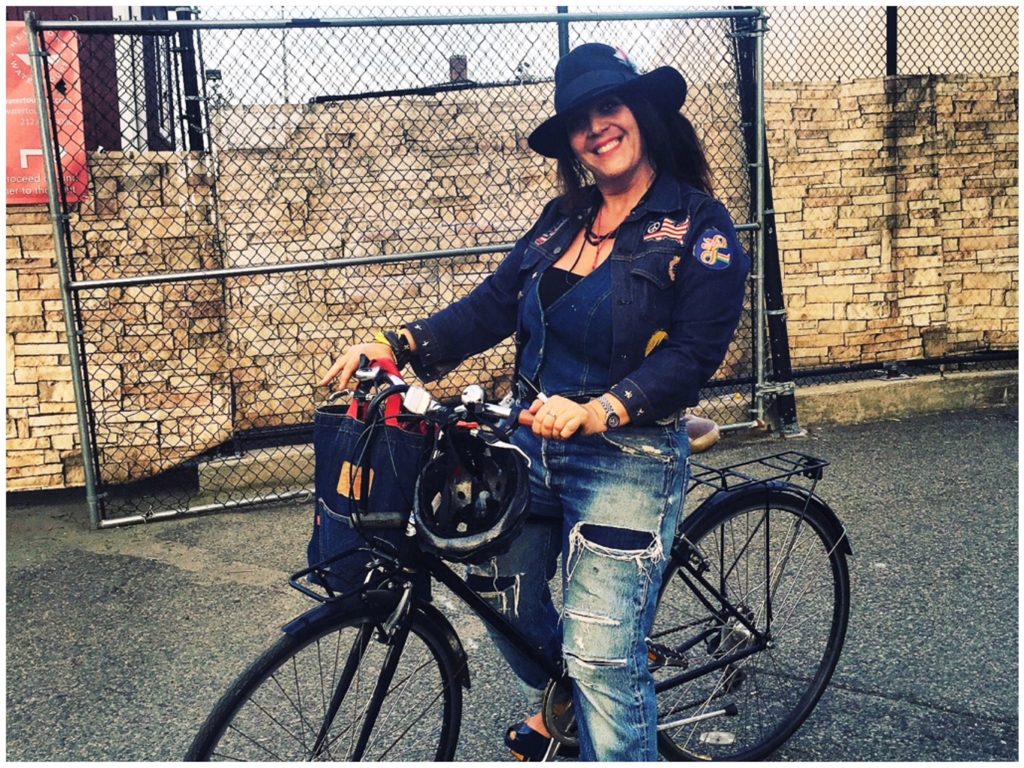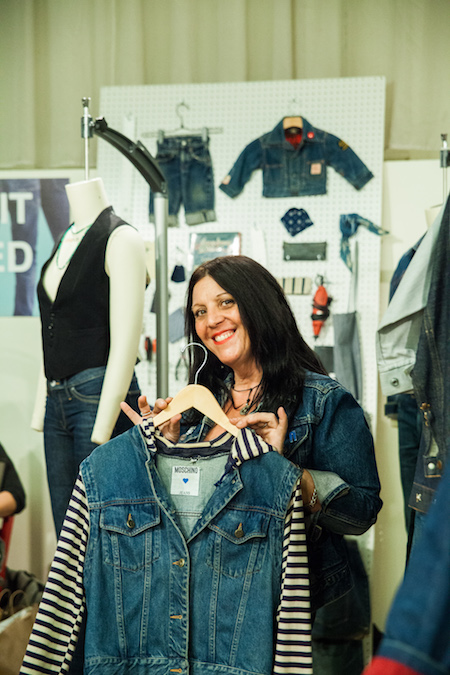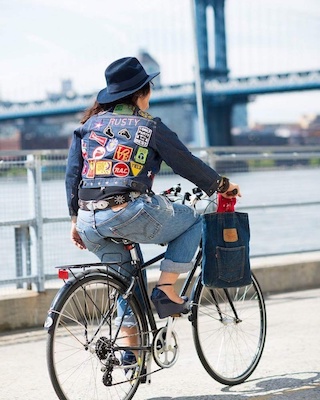
Godmother NYC Talks Denim Past, Present and Future
Anyone who has spent 35 years living and loving all things denim, deserves the “expert” moniker, and Christine Rucci is one such blueblood.
Rucci cut her teeth in the denim world at age 10, when she designed her first piece for a Levi’s-sponsored contest. From there, she custom designed used jeans she bought and found, giving them a vintage, distressed look. 
Since then, Rucci, also known as Godmother NYC, has achieved international success working for some of the most noted denim brands worldwide, including Calvin Klein, Ralph Lauren and Tommy Hilfiger, and Diesel. In 2004, she opened her own design consulting firm, and eventually launched her own line, 5EP.
Now Rucci is recognized as an authority on all things denim, often called on for sound industry advice, even flexing her skills in the 2014 denim documentary Blue Gold: American Jeans.
Carved in Blue spent some time with Rucci to learn about her storied denim past, her belief that TG3D body scanning is the future, and to understand how she’s been using her “denim intuition” to predict market trends.
Carved in Blue: How did you get started in the denim industry? What made you stay?
Christine: For me, design is literally in my “genes.” My great grandmother, an Italian immigrant, came to America in 1923 and worked in the Garment District as a seamstress. At age 10, I designed my first piece for a Levi’s-sponsored contest. It was years later, in August 1981, I bought my first W magazine, and upon seeing an ad for Ralph Lauren Roughwear, made a vow that I would become a designer and one day work for him. After studying briefly at FIT, I interviewed for Seventeen magazine and the fashion editor said she wasn’t going to hire me. I was crushed. She said I should get a job as a receptionist and put my sketches on the designer’s desk and one day someone would notice me. I took this advice and got a job at Puritan Fashions, which owned Calvin Klein Jeans. One day my boss asked if I spoke Italian, and next thing I knew I was moving to Italy to work for Genius Group. I got my formal denim design training working for Adriano Goldschmied, Renzo Rosso (Diesel), Claudio Buziol (Replay), and later, François Girbaud, who taught me about garment processing. I would travel to Italy and then work in the laundries in the south. I learned all about textile chemistry from Dave Smith, who was my mentor and the granddaddy of denim wet processing and garment dyeing in America. I then returned to New York and went on to work for Calvin Klein, Donna Karan and Tommy Hilfiger, where I helped launch Tommy Jeans, and finally Ralph Lauren, where I designed the Double RL line and learned, among other things, the importance of knowing the history of clothing. Ralph taught me you have to look backward to be forward, and to remember that vintage need to fit a modern person.
Carved in Blue: Why do you think brands and designers turn to you for denim insight?
Christine: I think it’s because of my “5Fs” philosophy. Fabric. Fit. Finish. Factory. And Fashion. I think fabric is the key driver of everything in denim. I can look at a raw piece of denim and just know it’s right. I call it my “denim intuition.” Then I focus on fit. Who is the customer? What is their shape? What do they do? I create the initial fit block and work to develop the pattern with the factory. I prefer working hands on with my patternmaker and sample hands in NYC and then send to the client. Then I will work closely with the designers for their inspiration, theme and concept. I will do extensive research, pull from my vintage archives and actually go blue gold mining. I create my own tech packs, and go to the factory to review each and every detail. I like to be there when they spread the denim and be on the sewing floor to review each operation to insure that it meets the brand’s needs, costing and ease of production. And finally, I love to be in the laundry or dye house. This is a place I spent most of my career. I traveled for more than 20 years working in the southern United States, Italy, Portugal, Hong Kong and Japan. More recently, I have gotten involved with hydro-less laser washing and ozone technology. It is very hard sometimes to be a “denim consultant” and be careful not to step on any creative toes. I am often on my hands and knees studying the garment at every angle, and will sculpt one side with pins to create the perfect fit. I feel very honored when designers allow me to do my denim magic. I think fashion trends are just an instinct. And I base a lot of this on music, art and even political climate of a period and how it relates to present day. Right now I am very focused on very specific years: 1950, 1976 and 1984. These years are very connected, yet different. I am usually early in my predictions. And when it happens, I know my crazy denim brain is validated. Sometimes I am seeing it years before a trend hits.
Carved in Blue: What has been your greatest accomplishment when it comes to your work in the denim industry?
Christine: It’s hard to pinpoint one single accomplishment in my 35 years in denim, but I would say having worked personally for many of the who’s who of the denim industry. My career highlights have to be working on a limited-edition RRL book for Ralph Lauren. And most recently helping British artist Ian Berry on The Secret Garden for the Children’s Museum of the Arts in NYC. I go there often. I am in awe that it is all out of denim, it is truly magical. I was very honored to be in the Blue Gold: American Jeans movie and a small part of the history of the denim industry. But I would say the single most important accomplishment was launching my own jeans brand 5EP. I took a leap of faith and quit my job at Ralph Lauren, sold my stock and cashed in my 401K to start my own jeans brand. I can recall the first trade sitting in the booth and was always used to being “the back of the house.” And here I was front and center selling. I am not sure if I ever slept. Then all of a sudden the brand was getting press before I shipped one jean, and I got orders from every major specialty store all over the world. But what was even more special was all the customers who contacted me. I saved all their info and have met many of them. I never knew how dedicated and passionate consumers are about jeans. I still keep in touch with many of my “denimafia” and count them not only customers but as friends.
Carved in Blue: What are you working on now that you think will have an impact on the denim industry?
Christine: Right now I am working with new technology called TG3D body scanning, which debuted at New York Denim Days. I saw the future over 10 years ago, when I created the first user-generated jean. I had gotten the idea from the sneaker industry. So together with a men’s denim blog, Styleforum, we created the perfect jean from data collected from 600 users. I think we sold out the entire lot of production in 30 minutes. As more and more people buy denim online, more than 80 percent is returned for fit/sizing. I think people look at the jean on a model online and get the jean and are disappointed. I am working on a new concept of “brand your own” denim, which is a business-to-consumer customized denim concept utilizing 3-D body scanning. I am dipping my toes back into the denim pool. I have been studying the denim market and see new opportunities. Based on seeing everyone on Citi Bikes pulling up on their bikes at the hitching posts on their blue horses, the modern-day cowboys, nine out of 10 people are wearing jeans. I am an urban rider and jeans lovers, so me and my design partner are working on a tight capsule collections that we plan to launch later this year. We are hoping to find the right financial partner to help take this brand to the next level. I believe incorporating fiber technology like Lenzing Refibra™, TENCEL™ Lyocell, as well with INVISTA’s dualFX® technology by LYCRA® and Coolmax® are an important part of my denim collection. I am calling this trend vintage tech.

Carved in Blue: What do you want to see next for denim?
Christine: I feel very strongly that denim weights need to get heavier. This whole lightweight denim trend needs to change. I feel as an industry we created a trend based on price and cotton production. Look at the sudden trend of 100 percent cotton vintage 13 to 14 oz. Levi’s jeans over the past couple of years. What happens when there is no more vintage jeans to repurpose? I think in these belt tightening times, jeans fits will be more relaxed and weight will be perceived as value. I see a revival of brand DNA and heritage, bringing back the jeans styles that made the brand that consumers wanted. This is where FIT becomes important. Stretch denim makes it much easier. Back in the day there were no stretch jeans. Why are these jeans so coveted? I am convinced it has a lot to do with weight. Look at Japanese denim. I also think mills need to develop less quantities and focus on their specialty. I feel it is denim overload both at the mill and garment level. It’s like an indigo sea of sameness at every price point. If you are great at doing indigo denim shirting, make denim shirting fabrics. If you have a specialty, then customers will come to you. I always say less is more. And I prefer a curated collection that is unique. I feel the same about jeans and fashion as a whole. I think there are too many choices. And in the end, all of that time, money, energy to be everything to everyone, goes to waste when in general mills produce less than 20 percent of what they develop. I also think denim brands need to help produce locally and support domestic production. We need to foster denim manufacturing, and consumers are willing to pay the price. I am a strong supporter of Made in USA and working with local government in NYC to help save the garment district.
Carved in Blue: When did you know you were a blueblood?
Christine: I went to Catholic school and had to wear a uniform every day. I would walk home and see other kids in Levi’s. I begged my parents for a pair. Instead I was given a Levi’s book bag, which I proudly carried to school. It irritated the nuns, as denim was against the rules. I guess you could say it was my form of rebellion. But it has to be the first time I tried a pair on. Back in the day you would go to the army and navy stores for Levi’s. I put them on, and I was hooked. The rest is history. People often ask me what I do, and I reply, “I’m a Denim Expert.” It is truly my life’s passion, as well as my original gene line.
Carved in Blue: What is your favorite pair of jeans?
Christine: For my day-to-day jeans, I love Levi’s 711. But I am yearning for heavier 100 percent cotton jeans and comfort stretch jeans in the right fabric and wash. This is why I feel so strongly about custom jeans, but at a reasonable price. Ultimately I think the future is custom-made DIY product at an affordable price. I think we all find that perfect fit for our bodies and wishes it came in different colors, fabrics and washes. Which harkens back to the old days when you went to the shop and had your clothes tailor made, brand my own.
Carved in Blue: If you could go anywhere in the world to shop for jeans, where would it be?
Christine: I have to say right in New York City. There is every brand here from all over the world and no shortage of denim jeans, vintage and new. I prefer to shop at brick-and-mortar, specialty stores over department stores and like the interaction with the sales associates. You can never have this experience online. I like trying on my jeans, and hate when I see it online and it arrives and is ill fitting or looks different.
Carved in Blue: Where do you turn for denim inspiration?
Christine: I found all of my denim inspiration pieces right in my own backyard, eBay and sometimes Etsy. I will find an amazing jeans at a stoop sale or street fair. Most of my favorite vintage stores to go blue gold mining are in lower Manhattan and Brooklyn. One time I found a Levi’s jacket made out of brown duck canvas in the street. I carried the dirty jacket home and washed it, and wear it to this day. I have a huge storage unit filled with denim I have been collecting for years. I pull a selection each season and make a mood board. This is my wardrobe that I rotate with new jeans to create my look for the season. I also love researching each item, which leads me to more denim information to file in my brain. I owe thanks to Ralph Lauren and my mom for this.
Carved in Blue: What does Carved in Blue mean to you?
Christine: To be “carved in blue” means you are cut from the cloth that has shaped a world, people’s lives, defined generations, a form of rebellion and a long love affair with denim.






